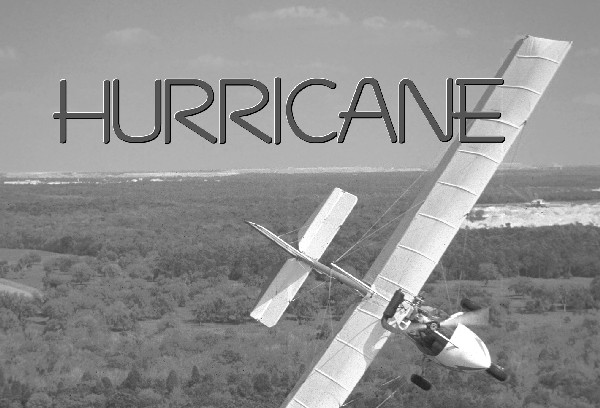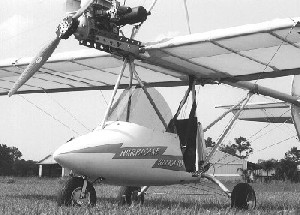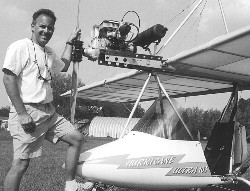

CLASSIC LINES – Hurricane does the original Phantom great justice, and has developed into a company with a whole line. This Hurricane Ultra 103 is the company’s fully Part 103 model.

TAIL VOLUME – Every designer wants to provide good tail volume to assure control. In my experience, tails can hardly be too large. The Ultra 103 tail shows good authority.

NEW BOSS – Since he bought Hurricane Company from Donnie Eccker, Mike Kern has been the captain of Oregon-based HY-TEK Hurricane. Kern was once a large dealer and struck a deal to take over the whole operation.

FUEL CELL – Hurricane’s fuel tank is not part of the seat, instead being bolted to the airframe directly. Note the fuel quantity indicator. If you loosen the shoulder harness straps a little, you can view this in flight.

WIRE-BRACED – This system works so well the Hurricane can be flown through mild aerobatics with confidence – and cables have less drag than struts of equivalent strength, say some designers.

MOVE UP! – To many pilots, an ultralight like the Ultra 103 is a great move up from your first basic ultralight. The lightest Hurricane works well with the Rotax 447 and can please many pilots’ skill ranges.

SLING SEAT – Some pilots aren’t sure about sling seats, though they should try this one first. Also note the sturdy 4-point shoulder harness system.

SIMPLE VIEW – An Ultra 103, fitting Part 103 including a 40-hp Rotax 447 engine and brakes, must keep other features low to stay within the weight limit. The cockpit has adequate room for all but the biggest pilots.
In barely a dozen years, the original Phantom has gone through at least four changes of ownership I can clearly recall. One of the imitators, the Avenger, ceased and was restarted only to stop again (and who knows, maybe it will live on yet?). Another imitator, the Spitfire, has endured at least three owners I can think of, and yet it, too, continues to be an available aircraft to this day. Finally, the Hurricane left the hands of founder Donnie Eccker and was passed to present-day owner Mike Kern.
| Seating | Single seat |
| Empty weight | 250 pounds |
| Gross weight | 500 pounds |
| Wingspan | 28 feet 6 inches |
| Wing area | 147 square feet |
| Wing loading | 3.4 pounds/sq ft |
| Length | 16 feet 9 inches |
| Height | 8 feet 3 inches |
| Load Limit | +6 Gs, -4 Gs |
| Fuel Capacity | 5 gallons |
| Kit type | Assembly |
| Build time | 80-100 hours |
| Set-up time | 30-40 minutes |
| Standard engine | Rotax 447 |
| Power | 40 horsepower |
| Power loading | 12.5 pounds/hp |
| Cruise speed | 55 mph |
| Stall Speed | 26 mph |
| Never exceed speed | 80 mph |
| Rate of climb at gross | 850 fpm |
| Takeoff distance at gross | 100 feet |
| Landing distance at gross | 120 feet |
| Standard Features | Flat-bottomed wing airfoil, full-span ailerons, mechanical drum brakes, steerable nosewheel, 4-point shoulder harness, 6-inch aluminum wheels, windshield, pod. |
| Options | In-flight trim, FreeAir scoop, extended windshield, skylight wing windows, ballistic emergency chute, ground-adjustable pitch 2-blade prop, instruments (ASI, tach, dual EGT, dual CHT, altimeter, hourmeter, compass, slip indicator, VSI). Hurricane Standard 103 ($8,499): Semisymmetrical wing airfoil, Rotax 447 engine, 254-pound empty weight, 525-pound gross weight, 100-mph Vne, +7 Gs and -5 Gs design load factors. |
| Construction | Aluminum tubing, stainless steel cable bracing, Dacron sailcloth covering, fiberglass pod. |
Design
Cosmetic appearance, structural integrity, achievement of design goals, effectiveness of aerodynamics, ergonomics.
Pros – Solid, proven design. Use of cable-bracing, though no longer as popular as struts, makes for a strong, stout-feeling airframe. Ultra 103 flown aerobatically by factory pilots (though such use is not promoted). Excellent low price for an ultralight sometimes called a “move up model.” Good blend of performance and handling. Ultra 103 fits under Part 103 even with 40-hp Rotax 447 engine and brakes! Manuals are very good with extensive computer-graphic illustrations.
Cons – For some novices, Ultra 103 may be a little too racy. If you want to add lots of options, the Part 103 constraints will prove too much. May not be optimal in cold-weather flying environments.
Systems
Subsystems available to pilot such as: Flaps; Fuel sources; Electric start; In-air restart; Brakes; Engine controls; Navigations; Radio; (items covered may be optional).
Pros – Helpful with ground operations, especially hard surfaces, brakes are included despite Ultra 103’s low price. Fuel quantity easily checked. Refueling is also easy and not likely to cause inadvertent spills on other parts of the ultralight. Access for engine repair is excellent. Pull starting worked well in cockpit, superior to most ultralights. Approved parachute installation.
Cons – At this price, and staying within Part 103, the basic Ultra 103 isn’t loaded up with systems. No flaps installed. Slips are less efficient than designs with fuller enclosures.
Cockpit/Cabin
Instrumentation; Ergonomics of controls; Creature comforts; (items covered may be optional).
Pros – Good windscreen; works very well to keep wind off the pilot. Proper 4-point shoulder harness was appreciated, as was the emergency parachute. Good control and instrument reach, though most pilots will have to loosen shoulder straps to get every switch. If you follow a procedure, entry is easy enough; a lower cockpit helps.
Cons – Owners may want to adjust seats to assure comfort for extended flights. Tractor engine configuration has some benefits but also obstructs vision somewhat and has less esthetic appeal to pilots accustomed to pushers. Entry requires a technique (feet first) without which you’ll struggle. No cargo area. Panel area limited.
Ground Handling
Taxi visibility; Steering; Turn radius; Shock absorption; Stance/Stability; Braking.
Pros – Adequate visibility up and forward; even better with optional wing windows (get them sewn in!). Excellent nosewheel steering with modest pedal pressures. Tight turn radius for a tri-gear ultralight. Standard wide tires help on turf or sandy surfaces. Very stable feeling on gear.
Cons – No differential braking available (it’s amazing HY-TEK Hurricane can fit brakes at all under the Part 103 weight restriction). Only suspension is gear leg flex (not much) and tire inflation. Even with wing windows, you’ll need to do a 360° to check traffic at the end of the runway.
Takeoff/Landing
Qualities; Efficiency; Ease; Comparative values.
Pros – Departure and approach visibility is quite good. With a little practice, very slow approach speeds are possible. Landing roll is short. Very good crosswind handling. After a few trials, takeoffs and landings will go very well. Generous ground clearance and tough gear make rough-field landings more reasonable.
Cons – No flaps available (not even on models that exceed Part 103 weight). Slips aren’t very efficient as fuselage has little side area. Ultra 103 bleeds off energy quickly; if you get slow on approach, flare timing will be more critical.
Control
Quality and quantity for: Coordination; Authority; Pressures; Response; and Coupling.
Pros – Handling is one of the Ultra 103’s best qualities. Snappy enough for more experienced pilots, the response is dampened enough for newer pilots. Excellent crosswind authority, more than adequate for normal operations. Very predictable handling characteristics. Dutch rolls possible to steep angles on first effort. Steep turns had plenty of stick range. Overall harmony was good.
Cons – Plenty of adverse yaw here (like every Phantom derivative I’ve flown). Rudder pedal pressures relatively higher than stick. No other negatives.
Performance
Climb; Glide; Sink; Cruise/stall/max speeds; Endurance; Range; Maneuverability.
Pros – With the Rotax 447 engine and a robust solid airframe, performance is very good in all measurements. Top-end speed is low 60s, fitting Part 103. Low-vibration power setting worked out to low 5,000 rpm, hitting 60 mph right on the nose. Low and slow maneuvering, flying low over huge grassy fields was satisfying as an ultralight should be.
Cons – Hurricane’s sink rate says something about the good handling; the tradeoff makes for a bit of a high sink rate (500 to 600 fpm in 2-minute test checks). Higher power settings required to sustain altitude. Endurance would be affected by this.
Stability
Stall recovery and characteristics; Dampening; Spiral stability; Adverse yaw qualities.
Pros – Ultra 103 stalls are very predictable. While they break, they always go straight ahead and recovery is very fast unless you hold controls at the full range of movement. Speed build-up after the stall wasn’t threatening. Spins are possible, recovery is very fast and nearly automatic with reasonable altitude loss. Longitudinal stability check was very good. Throttle response also positive. Ample tail volume gives a reassuring confidence to the Ultra 103 in all regimes.
Cons – Adverse yaw is substantial; Ultra 103 requires coordinated use of the controls to avoid. Speed build-up after spins required a more determined pullup to avoid exceeding speed limit. No other negatives discovered.
Overall
Addresses the questions: “Will a buyer get what he/she expects to buy, and did the designer/builder achieve the chosen goal?”
Pros – Excellent low price, held over a remarkably long time. HY-TEK factory support has earned good reports after a starting bump or two. Dealers in several U.S. locations. Owners tell me kits are quite complete, a demanding task that Hurricane evidently achieves. Design has a good history of its own and continues a Phantom-like tradition with class. Ultra 103 allows flight under Part 103 with a 40-hp Rotax 447, by itself enough to justify purchase.
Cons – Some ultralight pilots call the Phantom types a dated design. Lack of fuller enclosure may reject this design for cold-weather operators.


Are parts still available? After mangling the nose-wheel, I’m about to build a replacement since I can’t find them online.
Parts to similar airplanes still in production (Phantom Aeronautics) may suffice but very likely are not replacement parts.
I have Hy-Tek Hurricane with Rotax 503 engine and I was wondering what would be the best speed to take off, approach, and landing. I weigh about 160lb
You should most definitely get proper flight instruction. The following advice is not sufficient. However since you asked a basic question, a good rule of thumb for these aircraft is “50 is nifty,” meaning speed in miles per hour.